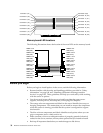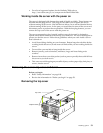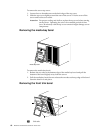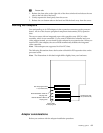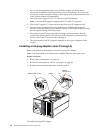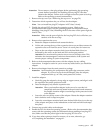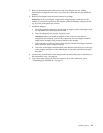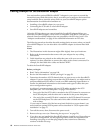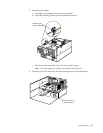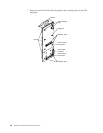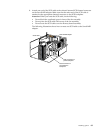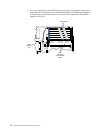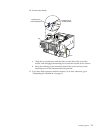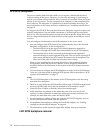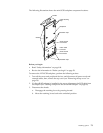
66 Hardware Maintenance Manual: xSeries 250
Cabling example for the ServeRAID adapter
You can install an optional IBM ServeRAID™ adapter in your server to control the
internal hot-swap hard-disk drives; that is, to enable you to configure the internal hot-
swap hard disk drives into disk arrays. Refer to your ServeRAID adapter option
documentation for additional information on:
• Installing a ServeRAID adapter in your server
• Connecting the SCSI cable to a ServeRAID adapter
• ServeRAID adapters and controllers
Select the PCI slot where you want to install the ServeRAID adapter. Before you
install the ServeRAID adapter, verify that it is compatible with the PCI slot that you
selected. Some ServeRAID adapters are not compatible with PCI slots 1 and 2. See
“Adapter considerations” on page 61 for additional information on PCI slots.
The following procedure describes the cable routing that is necessary when you install
a ServeRAID adapter. You can also cable a ServeRAID adapter to external hard disk
drives.
Notes:
1. The illustrations in this document might differ slightly from your hardware.
2. Refer to the documentation that comes with your adapter for any cabling
instructions.
3. Cable identifiers are printed on the cables that come with your server and
options. Use these identifiers to connect the cables to the correct connectors. For
example, the hard disk drive cables are labeled "HDD".
To cable the ServeRAID adapter:
Before you begin:
• Read “Safety information” on page 180.
• Review the information in “Before you begin” on page 58.
1. Determine the number of SCSI channels that you want to use on the ServeRAID
adapter. If you are connecting to more than two SCSI channels, you might need to
purchase additional SCSI cables. Consult your IBM marketing representative or
reseller for additional information on the number and types of cables that your
server configuration requires.
As shipped, your server comes with two SCSI cables attached to the SCSI
backplane (see “LVD SCSI backplane” on page 72 for details):
• One end of the first SCSI cable is attached to the SCSI channel A connector on
the SCSI backplane, and the other end is attached to the power backplane.
• One end of the second SCSI cable is attached to the SCSI channel B connector
on the SCSI backplane. The other end of this cable is folded and restrained
with a clamp.
If you want to connect all of the hot-swap hard disk drives to one channel, you
must install an optional SCSI repeater card as described in “SCSI repeater card
installation” on page 75.
2. Turn off the server; then, disconnect the power cords.
3. Remove the top cover (see “Removing the top cover” on page 59).
4. If you have not yet installed the ServeRAID adapter, install it now. Depending on
your server configuration, see the beginning of this section for instructions on
installing a hot-plug or non-hot-plug adapter; then, return here. Otherwise,
continue with the next step.



